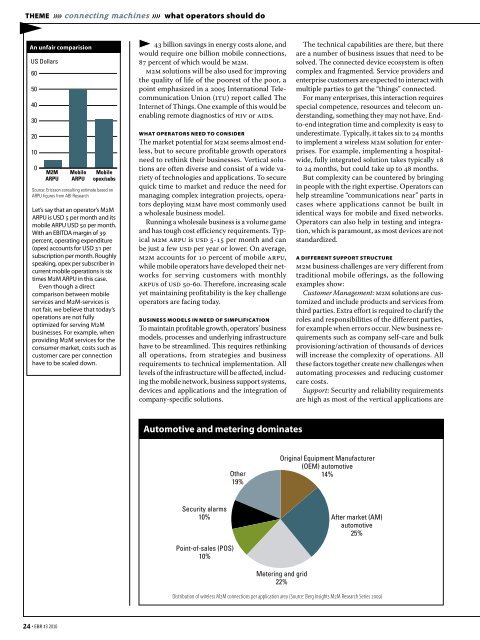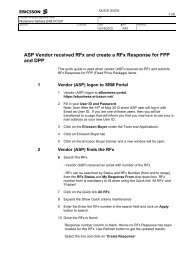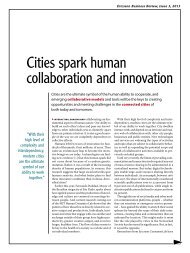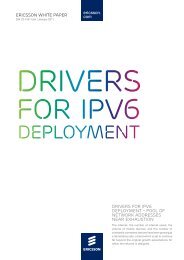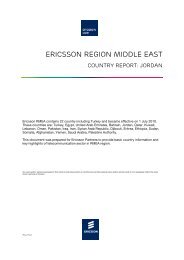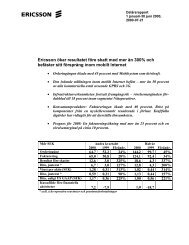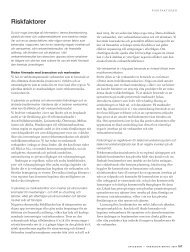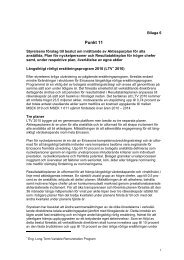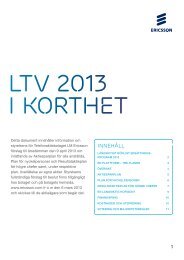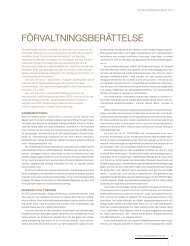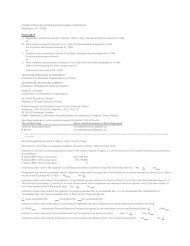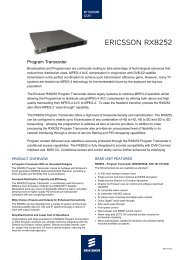Telenor's - Ericsson
Telenor's - Ericsson
Telenor's - Ericsson
- TAGS
- ericsson
- www.ericsson.com
You also want an ePaper? Increase the reach of your titles
YUMPU automatically turns print PDFs into web optimized ePapers that Google loves.
THEME »» connecting machines »» what operators should do<br />
▶<br />
An unfair comparision<br />
43 billion savings in energy costs alone, and<br />
would require one billion mobile connections,<br />
US Dollars<br />
87 percent of which would be m2m.<br />
60<br />
m2m solutions will be also used for improving<br />
the quality of life of the poorest of the poor, a<br />
50<br />
point emphasized in a 2005 International Telecommunication<br />
Union (itu) report called The<br />
40<br />
Internet of Things. One example of this would be<br />
30<br />
enabling remote diagnostics of hiv or aids.<br />
20<br />
10<br />
0 M2M<br />
ARPU<br />
Let’s say that an operator’s M2M<br />
ARPU is USD 5 per month and its<br />
mobile ARPU USD 50 per month.<br />
With an EBITDA margin of 39<br />
percent, operating expenditure<br />
(opex) accounts for USD 31 per<br />
subscription per month. Roughly<br />
speaking, opex per subscriber in<br />
current mobile operations is six<br />
times M2M ARPU in this case.<br />
Even though a direct<br />
comparison between mobile<br />
services and M2M-services is<br />
not fair, we believe that today’s<br />
operations are not fully<br />
optimized for serving M2M<br />
businesses. For example, when<br />
providing M2M services for the<br />
consumer market, costs such as<br />
customer care per connection<br />
have to be scaled down.<br />
24 EBR #3 2010<br />
Mobile<br />
ARPU<br />
Mobile<br />
opex/subs<br />
Source: <strong>Ericsson</strong> consulting estimate based on<br />
ARPU figures from ABI Research<br />
WHAT OPERATORS NEED TO CONSIDER<br />
The market potential for m2m seems almost endless,<br />
but to secure profitable growth operators<br />
need to rethink their businesses. Vertical solutions<br />
are often diverse and consist of a wide variety<br />
of technologies and applications. To secure<br />
quick time to market and reduce the need for<br />
managing complex integration projects, operators<br />
deploying m2m have most commonly used<br />
a wholesale business model.<br />
Running a wholesale business is a volume game<br />
and has tough cost efficiency requirements. Typical<br />
m2m arpu is usd 5-15 per month and can<br />
be just a few usd per year or lower. On average,<br />
m2m accounts for 10 percent of mobile arpu,<br />
while mobile operators have developed their networks<br />
for serving customers with monthly<br />
arpus of usd 50-60. Therefore, increasing scale<br />
yet maintaining profitability is the key challenge<br />
operators are facing today.<br />
BUSINESS MODELS IN NEED OF SIMPLIFICATION<br />
To maintain profitable growth, operators’ business<br />
models, processes and underlying infrastructure<br />
have to be streamlined. This requires rethinking<br />
all operations, from strategies and business<br />
requirements to technical implementation. All<br />
levels of the infrastructure will be affected, including<br />
the mobile network, business support systems,<br />
devices and applications and the integration of<br />
company-specific solutions.<br />
Automotive and metering dominates<br />
Security alarms<br />
10%<br />
Point-of-sales (POS)<br />
10%<br />
Other<br />
19%<br />
The technical capabilities are there, but there<br />
are a number of business issues that need to be<br />
solved. The connected device ecosystem is often<br />
complex and fragmented. Service providers and<br />
enterprise customers are expected to interact with<br />
multiple parties to get the “things” connected.<br />
For many enterprises, this interaction requires<br />
special competence, resources and telecom understanding,<br />
something they may not have. Endto-end<br />
integration time and complexity is easy to<br />
underestimate. Typically, it takes six to 24 months<br />
to implement a wireless m2m solution for enterprises.<br />
For example, implementing a hospitalwide,<br />
fully integrated solution takes typically 18<br />
to 24 months, but could take up to 48 months.<br />
But complexity can be countered by bringing<br />
in people with the right expertise. Operators can<br />
help streamline “communications near” parts in<br />
cases where applications cannot be built in<br />
identical ways for mobile and fixed networks.<br />
Operators can also help in testing and integration,<br />
which is paramount, as most devices are not<br />
standardized.<br />
A DIFFERENT SUPPORT STRUCTURE<br />
m2m business challenges are very different from<br />
traditional mobile offerings, as the following<br />
examples show:<br />
Customer Management: m2m solutions are customized<br />
and include products and services from<br />
third parties. Extra effort is required to clarify the<br />
roles and responsibilities of the different parties,<br />
for example when errors occur. New business requirements<br />
such as company self-care and bulk<br />
provisioning/activation of thousands of devices<br />
will increase the complexity of operations. All<br />
these factors together create new challenges when<br />
automating processes and reducing customer<br />
care costs.<br />
Support: Security and reliability requirements<br />
are high as most of the vertical applications are<br />
Original Equipment Manufacturer<br />
(OEM) automotive<br />
14%<br />
Metering and grid<br />
22%<br />
After market (AM)<br />
automotive<br />
25%<br />
Distribution of wireless M2M connections per application area (Source: Berg Insights M2M Research Series 2009)


